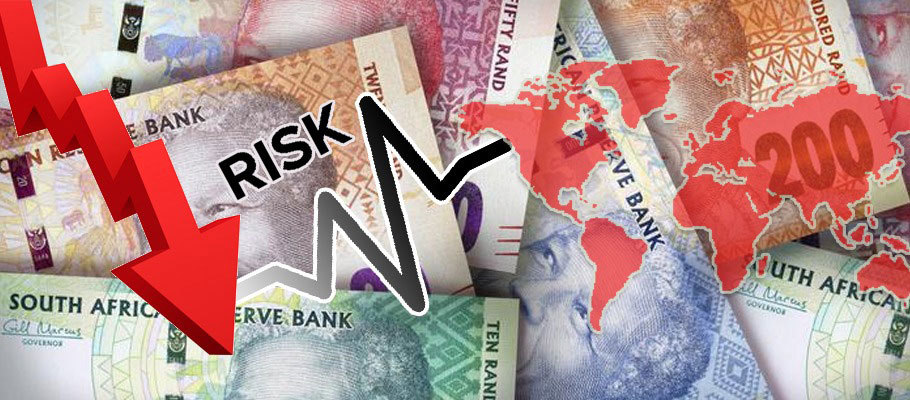
Published: September 20th, 2021
The South African rand saw a sharp fall as last week’s trading session concluded. The slide came after a period of strength that saw ZAR lifted by commodity prices and a supportive global backdrop.
Analysts seemed caught off-guard by the price slump, which occurred as global equity markets were recovering and a continued elevation in prices of manufacturing raw materials. These market variables would normally give the rand a boost.
Instead, ZAR closed last Friday with declines of 0.79 per cent against sterling and 0.71 per cent against the US dollar. That was in stark contrast to rising equity markets in Europe, which investors seemed to interpret as a 'risk on' signal after overnight rises in North America and Asia.
A daily forex market briefing from Citi said the rand’s descent was ‘surprising given the positive off-shore backdrop in equities. We believe local data must be responsible for the price move.’
That’s a reference to South Africa's retail sales data for July, which fell by a whopping 11.1 per cent year-on-year. Markets were expecting a drop, but in the 2.5 per cent range.
As stock exchanges globally generated gains across major indices, South Africa’s bourse saw its main JSE index fall by 0.7 per cent.
Investec’s global economics unit published a market analysis suggesting that investors may have been prompted to take a harder look at South Africa's economic forecasts after the surprise retail sales slump.
‘Political unrest in parts of the country clearly hurt the retail sector. Some large chain stores were targets for arson and looting, which caused many retailers to stay closed for extended periods, in even areas not directly affected by protest.’
Civil disturbance and domestic economic figures will continue to present a challenge to growth, say economists, as worried traders cash out their ZAR positions.
‘We’re seeing some profit-taking now given the series of gains rand has experienced since early September,’ wrote Citi.
The pound-to-rand exchange rate could see a fourth successive daily advance today, and was quoted as high as 20.07 on Friday, having dropped below 19.47 a few days before. The dollar-to-rand rate was rising at Friday’s close.
With a worrying political and economic outlook, any investor looking for buying opportunities amongst the country's local debt and equity offerings will see potential headwinds, not least rising joblessness.
Unemployment figures hit above 34.3 per cent in Q2 of 2021, the highest number recorded since the country began surveying its labour force.
Investec says this ‘has to be a critical concern for investors.
‘Combined with poor retail figures and what we expect will be a lower consumer confidence reading this month, the growth trajectory for household spending will likely be negative in the short-term.
On Monday, the rand was one of the forex market’s outperformers, coming off a previous session with gains that analysts thought might persist thanks to recovery commodity prices and buoyant demand for South African mining output.
ZAR had outpaced both major and emerging economy fiats and was closing in on three-month highs against sterling and the greenback the previous Friday (10th September), borne aloft by swelling domestic and international tailwinds.
A retreating US dollar gave support to many currencies in the period. Still, rand was the standout performer, thanks to an earlier round of positive local economic data that seemed to point to improving fundamentals behind the currency.
‘We’re seeing a notable outperform trend by ZAR relative to other currencies this week,’ said Rand Merchant Bank’s forex strategy unit in a note to investors on 10th September. ‘The rand has moved up two and a half per cent in five days. We believe that’s been driven in part by South Africa’s positive current account balance’.
Statistics South Africa published a strong second-quarter reading of the country’s current account balance, which showed a balance of payments surplus that reached a record high of more than five per cent of GDP.
That positive shift suggests a reduced need for any influx of foreign capital to keep the rand supported. It also weighs on the plus side when economists are conducting measures of a currency’s fundamental value.
The most significant contributor to the 340 billion rand surplus was a steep uplift in international trade caused by strong export growth, something aided significantly by rising prices for metals.
Economists at BNP Paribas told Reuters that external tailwinds were positively impacting South Africa’s net trade balance. ‘We expect to see a current account surplus of 3.7 per cent of GDP by the time 201 ends. That would be a new high and probably helped by low inflation and low wage growth.’
Commodities have been one of the positive market stories of 2021, as prices for all kinds of raw materials have surged on optimism about a return to normal in the global economic outlook.
Quantitative easing by central banks, low interest rates, and improving central bank balance sheets can all give commodity prices a lift, especially after a period of crisis.
Economic disruption tends to push major central banks into stimulus mode to keep demand and spending going, with a corresponding impact on commodity prices.
If those factors remain in place over the coming months, ZAR could see a return to strength and resilience despite the retrenchment seen late last week.
South Africa’s and other nation's central banks could also remain a factor if the policy guidance from the Federal Reserve, European Central Bank and others points to a continuation of low interest rates and quantitative easing programmes going well into next year.
‘Under those conditions, we can expect commodity prices will probably continue to hold their current levels of even rise, pushing the central banks behind the world’s commodity currencies to tighten up their policies, added Citi.